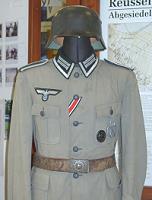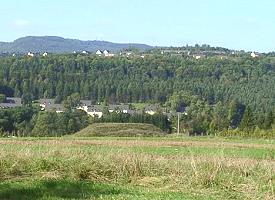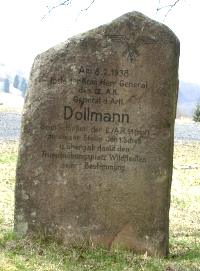The Beginning...
|
|
In 1935 Adolf Hitler ordered the creation of a new German army. After World War I, Germany's army was restricted to 100 000 men. No armored or air-troops were allowed. The "new" German "Reich" (empire) called for a modern, strong army, navy and air force. New training-areas and garrisons had to be established all over Germany. The 9th Army Corps, which was headquartered in Kassel, saw the need for a training-area in the highlands. In the Rhoen-Mountains they found what they were looking for. Also, the area was not much populated and there was good infrastructure, such as rail-road and state highway (Reichsstraßen) connections. |
 |
|
The training-area in its final layout consisted of 18 000 acres of land. Surveying began in spring of 1936, Major construction was commenced in 1937. One year later, in February 1938 the first unit arrived for training at Wildflecken. It was an Infantry Regiment that was based in nearby Fulda.
The train station and the camp became connected by a broad road that was paved with cobble-stones. Wildflecken was also within the reach of the state-highways (Reichstraßen) 27, 286 and 287. Throughout the training-area ranges and supporting facilities for Armor, Infantry and Artillery units were built. Work on roads and facilities was continued during the war. French, Belgian and Russian Prisoners of War were used to carry out those work. A total of about 2 000 residents of 10 villages, which were now located within the limits of the new training-area had to be relocated by the end of May 1938. The "Reichsumsiedlungsgesellschaft" (Relocation Agency) made a new farms available for the villagers or gave them monetary compensation for their lost homes. To make the camp as invisible as possible, all buildings were placed inside the already existing woods. Every tree to be cut down needed a special permision. This natural camoflage saved Camp Wildflecken from bombing up to the war's end. About 8 000 workers, architects and engineers worked 24/7 for to finish major construction within 1 year. During the winter, big heated tents were erected to cover the building sites. The design of most buildings was inspired by the local "Franconian" framework-style. Besides the camp and the training facilities, housing for officers and civilian employees was build in the outskirts of the village of Wildflecken and right beside the main-gate.
On 8 February 1938 General Dollmann, commanding General of the 9th Corps fired the first artillery shell to mark the inauguration of the Wildflecken Training Area. To house at least a part of the workforce that was employed to work at the various camp's and infrastructure's building sites, a temporary camp was built between the train-station and the camp's building site. During the war this camp was used to accomodate about 2 000 French and Belgian prisoners of war before it burned down by arson in 1947. |
 To accomodate units that came here for training, a camp, big enough to hold about 9,000 soldiers and 1,500 horses, was built on a hill east of the village of Wildflecken. The train-station was expanded and a ramp for loading and unloading of tracked and wheeled vehicles was added.
To accomodate units that came here for training, a camp, big enough to hold about 9,000 soldiers and 1,500 horses, was built on a hill east of the village of Wildflecken. The train-station was expanded and a ramp for loading and unloading of tracked and wheeled vehicles was added. 